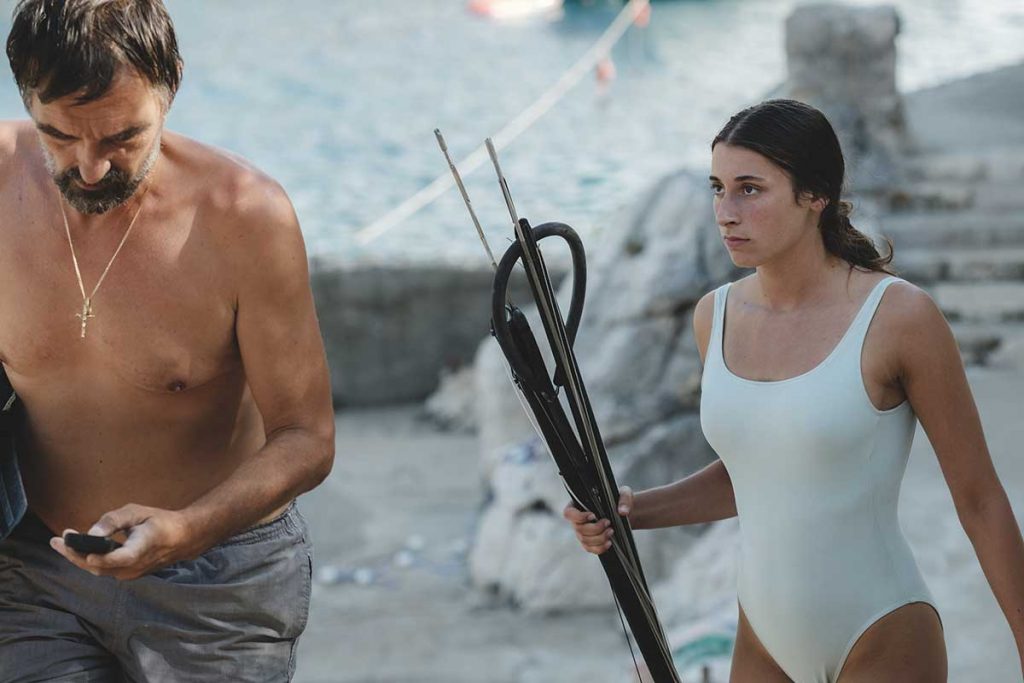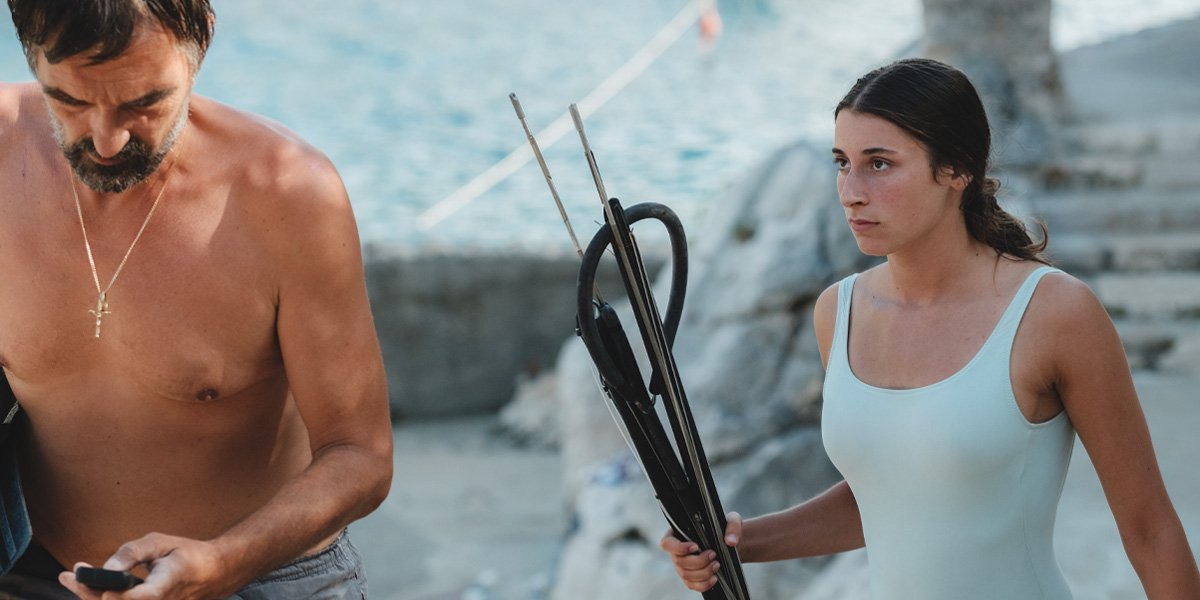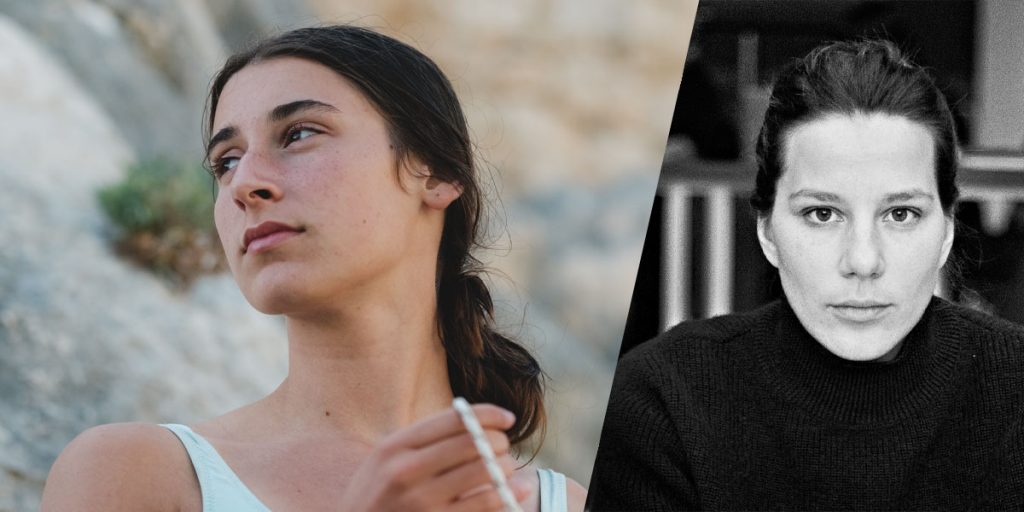Ahead of its UK release, we interview director Antoneta Alamat Kusijanović about her Caméra d’Or-winning film, Murina.
With her feature film directorial debut Murina, Antoneta Alamat Kusijanović has created something uniquely unsettling and deeply memorable. This chilling psychological family drama follows teenager Julija (Gracija Filipović) during a holiday to the Adriatic coast with her father and mother, focussing on the former’s abusive control over her. With the arrival of a charming and mysterious family friend, the tension rises with each moment, burning intensely under the bright spotlight of the Mediterranean sun.
Kusijanović’s expertly paced screenplay and considered direction, along with memorable performances from the cast and striking cinematography from Hélène Louvart (Happy as Lazzaro, The Lost Daughter), ensure Murina is wholly absorbing and terrifying in its depiction of hypermasculinity, but also inspirational in the strength it draws from its central female protagonist.
With Murina due for UK release in April 2022, we interviewed Kusijanović to discuss the film’s atmosphere, the creative process and more, giving us an insight into how this sharp, unforgettable drama came to fruition.
Combining Terror and Beauty in Murina
Thank you for speaking to us today. We loved Murina. The film has this very real, palpable sense of dread which builds up slowly and steadily, before blowing up near the end. Can you tell us about how you managed to build this atmosphere?
Antoneta Alamat Kusijanović: I’m personally very sensitive to small dynamics, so for me, it’s like, no! These are big beats! They hit so hard and feel scandalous. I never saw them as small beats but stepping back and creating a structure that the audience can follow, it ends up being treated with a lighter hand. But I’m aware that, for the characters, these are big shifts emotionally, so the combination of these two things creates the tension.
The beats all build up into one. All these moments get bigger and bigger until the end.
AAK: It’s my favourite thing to do and it’s very hard [forming these moments]. Every time, it’s really about writing, then going back and weighing everything up. Human nature is dreadful, but it’s also gorgeous, beautiful and splendid.
Touching on this theme further, the setting of the film is a very beautiful, idyllic place, with all these horrible events going on within it.
AAK: Isn’t it always like that? The most horrific things always happen when confronted with beauty. I don’t think real drama or terror is specifically reserved for dark alleys or the middle of the night. The architecture determines characters’ behaviour. For them, being in this very hot, utopian, blue, serene place is a depiction of hell, especially when there is no shade or trees. There is nowhere for them to think twice or calm down.
They’re just in the sun constantly.
AAK: They are burning. It’s like some kind of torture that they should be grateful for.
Was the setting always going to be the Adriatic Sea?
AAK: Yes. The setting determined their behaviour. They couldn’t behave like that in an apartment with air conditioning. I’m very determined to work with architecture, both manmade and nature. We behave completely differently in relation to the physical place we are in, not only in terms of our physical movement, but also psychologically.

The Process: Kusijanović on Working with the Cast & Crew
Hélène Louvart’s striking cinematography really enhances this dread situated within beautiful surroundings. Had you seen any of her previous work that made her stand out to you? How did she come on board with Murina?
AAK: She really is the best cinematographer of our time. I watched Happy as Lazzaro (2018) at New York Film Festival [Louvart is DOP for this film] and it shook me. I came out of the cinema and I tried to understand what had happened to me, because the film was working on these subconscious, ethereal levels. I was so moved. I really wanted to work with Hélène as she had made this complex thing very simple. She’s very intuitive and is able to simplify complex structures and dynamics.
The chemistry between the main cast is fascinating and so different between each of them. What was the process like in finding these four cast members and was it important to you how they all worked off of one another?
AAK: I cast Gracija Filipović [as the lead role of Julija] after my short film Into the Blue. I really wrote Murina and shaped the story for her, considering her strengths and what she could express the most. I then built the rest of the cast to her, with lots of test castings involving Gracija. Then they spent 30 days together in a house as a family! Sometimes they would be six hours or so together in a scene, other times cooking together, or waking up at 4am to go fishing.
Did any of them bring anything different or unexpected to their role?
AAK: You want actors to have the needs, values and wants of these people on the page. But in front of the camera, they are their own flesh, and their own physicality always brings things to the roles. And their movement is determined by the dynamics that need to be created on set. I’m the type of director who does not improvise much. I’m very open to improvisations before the shoot, for people to bring their own views, lines, or even scenes, but only really in pre-production. But of course, the tempo and rhythm changes in different ways during the shoot.
We’ve touched on Gracija Filipović, who plays Julija. Her character is very interesting, as she receives all of this abuse, but it doesn’t just turn her into something weak. It builds up her strength instead, which was refreshing. Was it your aim to do that? How difficult was it to balance the suffering of Julija with her strength and power?
AAK: When portraying teenage women or men, it is very important to remember that they are complex. I’ve heard that Murina doesn’t feel like a feminist film because it’s so sensual, as well as due to the fact that Julija is not angry or violent, but only strong. But why would she need to be angry or violent? We don’t create characters on screen for propaganda, to mirror what people assume female films need to be like. It’s unfortunate when people fall into that trap. Every character is unique and they can be both sensual and feminist.
There is a lot of symbolism in Murina, such as the moray eel. Was this symbolism always within your mind or did it often form and happen naturally?
AAK: It was one of the first things that happened in my mind. I really think the fish [the moray eel] is regal and gorgeous. She looks so dangerous, but she’s not like a shark. She has her own spot and once disturbed, she defends it, and I really like the extent to which she defends it. This is a fish who is ready to bite herself, and I wanted that fish to be my main character. Plus, she has two sets of jaws: one that bites, and one that disfigures.
That adds even more layers!
AAK: The fish is just Julija. She is ready to sacrifice her own family for her freedom, and eventually her own life. All to get out of that cage!

 loudandclearreviews.com
loudandclearreviews.comThe Future: Making a Mark and What’s Coming Next
Are you hopeful that Murina can inspire people and effect change within society?
AAK: That would be very egotistical of me, but of course I would hope that. I made it for 16-year-old selves. We all need to remember the resilience we had in our youth. That is the first thing that gets lost as we get older. I also always make movies with the awareness that someone needs to watch them. I want people to see them and be moved by them.
You’ve just won the Camera d’Or at Cannes for Murina. Have you got any future projects you’re working on that you can tell us about?
AAK: I am working on a film set between New York and Mexico. It’s a mother-daughter story within a setting of beautiful colours and dark sensuality.
This interview has been edited for length and clarity.
Murina is now available to watch on digital and on demand.

